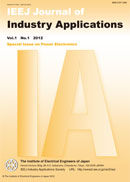Volume 10, Issue 4
Displaying 1-12 of 12 articles from this issue
- |<
- <
- 1
- >
- >|
Invited Paper
-
2021Volume 10Issue 4 Pages 402-410
Published: July 01, 2021
Released on J-STAGE: July 01, 2021
Advance online publication: May 14, 2021Download PDF (3542K) -
2021Volume 10Issue 4 Pages 411-416
Published: July 01, 2021
Released on J-STAGE: July 01, 2021
Advance online publication: April 02, 2021Download PDF (3008K)
Paper
-
2021Volume 10Issue 4 Pages 417-427
Published: July 01, 2021
Released on J-STAGE: July 01, 2021
Advance online publication: April 16, 2021Download PDF (3877K) -
2021Volume 10Issue 4 Pages 428-435
Published: July 01, 2021
Released on J-STAGE: July 01, 2021
Advance online publication: April 23, 2021Download PDF (1544K) -
2021Volume 10Issue 4 Pages 436-442
Published: July 01, 2021
Released on J-STAGE: July 01, 2021
Advance online publication: March 26, 2021Download PDF (3189K) -
2021Volume 10Issue 4 Pages 443-456
Published: July 01, 2021
Released on J-STAGE: July 01, 2021
Advance online publication: April 09, 2021Download PDF (5525K) -
2021Volume 10Issue 4 Pages 457-468
Published: July 01, 2021
Released on J-STAGE: July 01, 2021
Advance online publication: April 30, 2021Download PDF (2339K) -
2021Volume 10Issue 4 Pages 469-480
Published: July 01, 2021
Released on J-STAGE: July 01, 2021
Advance online publication: March 12, 2021Download PDF (2431K)
Selected and English Translation Paper of IEEJ Trans. IA
-
2021Volume 10Issue 4 Pages 481-486
Published: July 01, 2021
Released on J-STAGE: July 01, 2021
Advance online publication: March 19, 2021Download PDF (1692K) -
2021Volume 10Issue 4 Pages 487-496
Published: July 01, 2021
Released on J-STAGE: July 01, 2021
Advance online publication: April 30, 2021Download PDF (3498K) -
2021Volume 10Issue 4 Pages 497-505
Published: July 01, 2021
Released on J-STAGE: July 01, 2021
Advance online publication: May 21, 2021Download PDF (1506K)
-
2021Volume 10Issue 4 Pages L4_1
Published: July 01, 2021
Released on J-STAGE: July 01, 2021
Download PDF (543K)
- |<
- <
- 1
- >
- >|
